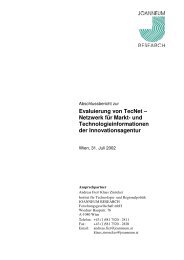roadMAP [PDF, 1.9 MB] - fteval
roadMAP [PDF, 1.9 MB] - fteval
roadMAP [PDF, 1.9 MB] - fteval
Create successful ePaper yourself
Turn your PDF publications into a flip-book with our unique Google optimized e-Paper software.
Finally it has to be said that design and management of MAPs are closely interlinked elements<br />
of one process, though often managed by different actors. Even some of the activities we called<br />
“network gardening” are part of a MAP preparation process. The more coherent a network<br />
oriented RTDI policy acts, the more harmonic different programmes – including MAPs – and<br />
other preparatory and accompanying measures will interact.<br />
4.2.3 The roles of MAPs in innovation systems<br />
MAPs are funding programmes and only part of an overall systems oriented RTDI policy<br />
approach. While “Multi Measures” and “Multi Actors” are always a necessary precondition within<br />
an explicit programme structure, the way of approaching different actor settings can be very<br />
different and distinct. (see chapter 2 on Definition of MAPs). Within our sample of MAPs and<br />
beyond we can roughly distinguish (i) network- / cluster-oriented MAPs and (ii) Centre<br />
programmes; the latter forming cooperatively funded and governed research entities generally<br />
called Competence Centres.<br />
The function of all MAPs is to change actor settings and trajectories via temporarily funded<br />
projects or centres within programmes. On a policy level it is important to see that also other<br />
kinds of interventions like new institutions or regulatory measures could be possible answers to<br />
the challenges described above. The advantage of programmes including MAPs is their<br />
temporary, direct and adaptable character and their ability to influence institutional and systemic<br />
settings. Metaphorically speaking all forms of MAPs can be used in three following ways:<br />
• As a kind of glue, linking together important parts of an innovation system, which would not<br />
link up at all / that fast / that strongly etc. A typical gluing activity is science – industry<br />
cooperation which is seen as crucial in innovation systems but faces a lot of barriers in both<br />
worlds. MAPs can contribute in this way to “produce” behavioural additionality – which in our<br />
case is also one of the most important evaluation criteria of such cooperation funding<br />
schemes.<br />
• As a kind of solvent, changing rules, habits and incentives within subcultures. As we know<br />
from innovation research, trajectories always happen and they can be traps. Organisations<br />
find themselves locked in routines and need an incentive to change, to go into new kinds of<br />
research, new partnerships, new internal arrangements etc.<br />
• As a kind of bypass, building roads around traditional blocks which are hard to change.<br />
Typical examples are strong departmental structures within universities or research<br />
institutions which will not perish overnight. MAPs can build ways around such disciplinary<br />
pillars by establishing new forms of long-term cooperations (compare ISI / KMFA 2004).<br />
engender enthusiasm for new beginnings (Boekholt et. al. 1998). Bührer et al. (2002) recommend three<br />
corresponding policy instruments which are derived from the portfolio of all state technology and innovation<br />
policy: resource policies to activate the network potential, e.g. by financial promotional funds, infrastructure<br />
equipment, improvement of access to venture capital (VC); advice on strategic development potentials; "long<br />
promotional breath" corresponding to the long-term development tradition of grown models in order to achieve<br />
the necessary sustainability of network dynamics after the promotional measure is finished.<br />
<strong>roadMAP</strong> 19


![roadMAP [PDF, 1.9 MB] - fteval](https://img.yumpu.com/21079876/24/500x640/roadmap-pdf-19-mb-fteval.jpg)

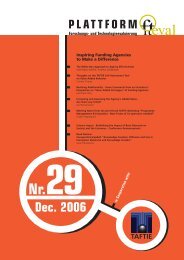
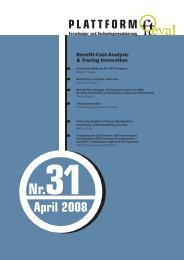
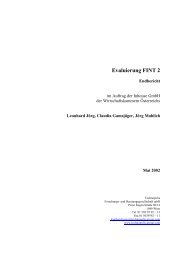
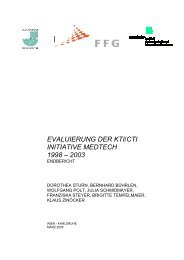
![GuggenbergeronBoku [PDF, 73.4 KB] - fteval](https://img.yumpu.com/21024081/1/184x260/guggenbergeronboku-pdf-734-kb-fteval.jpg?quality=85)
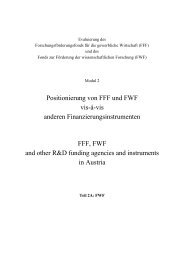

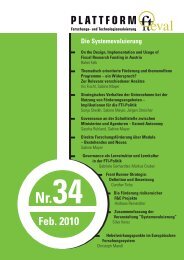
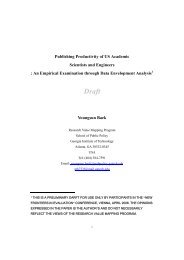
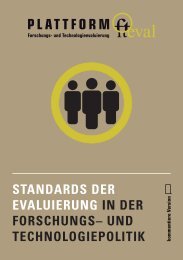
![ITF_Energietechnik [PDF, 39.6 KB] - fteval](https://img.yumpu.com/20959076/1/184x260/itf-energietechnik-pdf-396-kb-fteval.jpg?quality=85)
![Evaluation Standards [PDF, 120.8 KB] - fteval](https://img.yumpu.com/20931509/1/184x260/evaluation-standards-pdf-1208-kb-fteval.jpg?quality=85)
